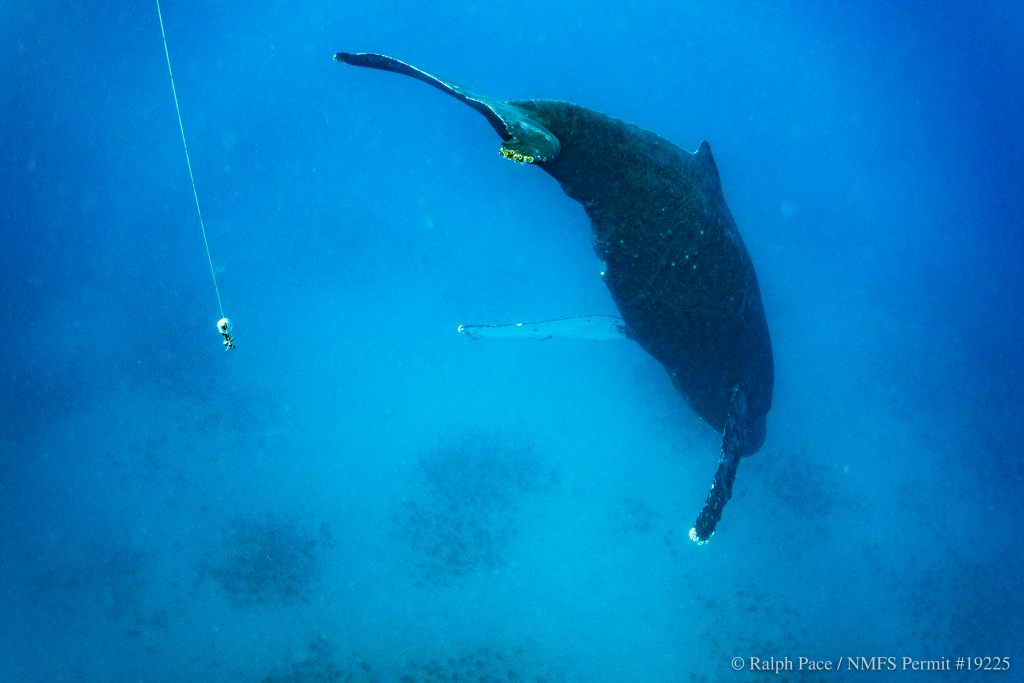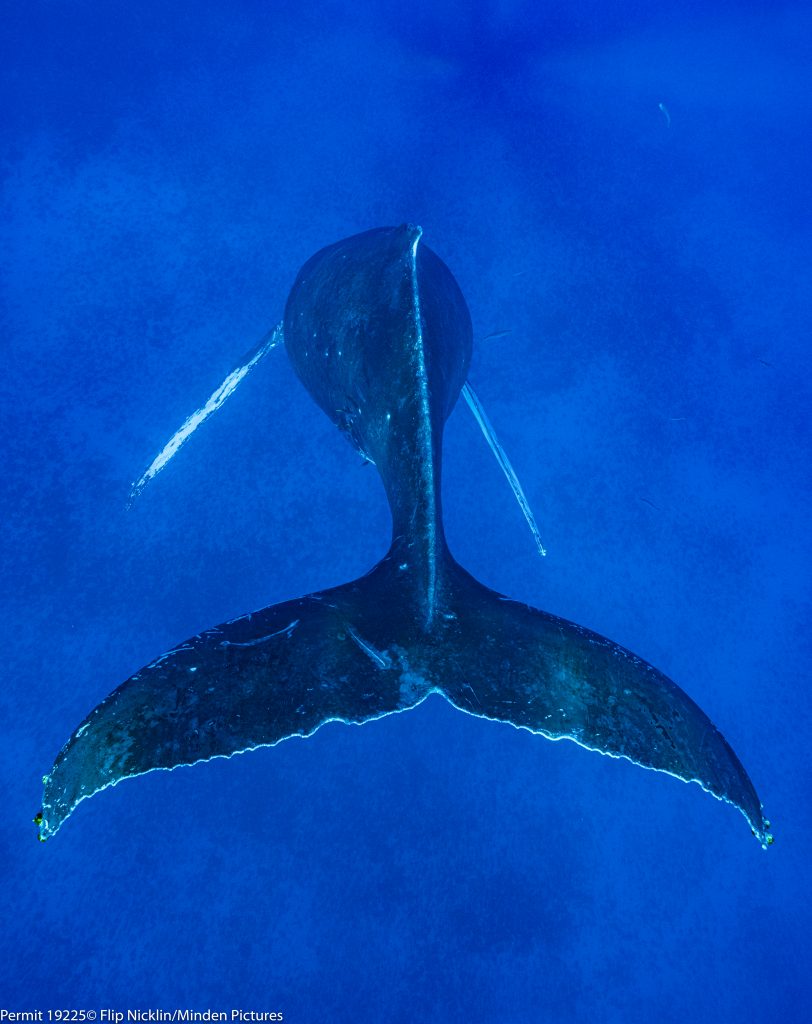A Whale of a Tale: Roger Payne’s Album of Humpback Songs Still Resonates 50 Years Later
In 1966, biologist Roger Payne traveled to Bermuda to meet a Navy engineer who had recorded mysterious sounds during a top-secret mission to listen for Russian nuclear submarines.
“I did not give a damn about anything top secret,” Payne said during a recent phone interview from his home in Vermont. “All I wanted to hear was the whales.”
Payne, now 86, still vividly remembers that trip more than a half century earlier. In Bermuda, he boarded a wooden mind sweeper and went into the engine room where the Navy’s Frank Watlington reached into his pocket and pulled out a roll of tape. On it were recordings made from a hydrophone towed behind the boat during the Cold War.
Watlington threaded the tape on a reel-to-reel tape recorder. Once done, Watlington put on headphones, made a few adjustments and then handed the headphones to Payne.
“The generator was going; it was really loud,” Payne said. “Frank shouted at me: ‘I think these may be whale sounds.’ In the impossibly awful acoustic situation, the headphones made it possible to hear. And I never had heard anything like it in my life.
“It blew my mind. Right at that moment, it was dead obvious that these sounds would get the world interested in whales.”
Payne was right. The recordings led to the 1970 popular album “Songs of the Humpback Whale,” which sold more than 100,000 copies and helped spark a worldwide conservation movement to stop whalers from hunting the magnificent marine creatures to extinction.
On Saturday, Feb. 13, Payne will be the guest speaker to kick off Maui’s 15th Annual Whale Tales event, hosted by the Maui-based Whales Trust.
This year’s Whale Tales event also celebrates the 50th anniversary of Payne and Scott McVay’s landmark paper on the songs of humpback whales that made the cover of the magazine Science in 1971, and the groundbreaking environmental album released the year before.
Due to the pandemic, this year Whale Tales will be virtual on Feb. 13 and 14. But the event still will feature more than 50 leading scientists, photographers, musicians, photographers and videographers from around the world. Like Payne, they all have dedicated their lives to understanding the communication and social behaviors of whales.
For a schedule and to register, go to www.whaletales.org. The cost is a tax-deductible minimum donation of $60. There also are student, educator and kamaʻāina discounts.
Among the scientists participating is Jim Darling, PhD, a member of the Whale Trust’s research team. He will be giving a presentation about the “North Pacific Humpback Whale Song,” which will be followed by a presentation about the “South Pacific Humpback Whale Song” by Ellen Garland, PhD, of the University of St. Andrews.
During a recent phone interview from his home on Vancouver Island, Darling said he loves the “spectacular” story about Payne getting the first known whale sound recordings in Bermuda, and then “introducing them to the world” at a time when whales were facing decimation.
Darling met Payne in 1977, when Payne was on the committee overseeing Darling’s Masters study on gray whales. During a particularly cold evening, Darling attended a meeting at which Payne asked him if he knew anyone who wanted to travel to tropical Maui to record whale songs.
I said, ‘Yeah, I know somebody,” Darling said. “I’ll do it.”
About a month later, Darling was on a Zodiac rubber boat in waters off Lahaina trying to record whale sounds that were usable for analysis. He has been studying whale sounds ever since, with some questions answered and some still a mystery.
Payne didn’t set out to study whales. He was cleaning his desk at Tufts University in Massachusetts, where he was investigating moths for his postdoctoral studies, when he heard on the radio about a dead whale washed up on nearby Revere Beach.
It happened long after Payne had attended a “totally disturbing” Harvard seminar about whales heading toward extinction, by a man who ran the Bureau of Internatonal Whaling Statistics. At that point, the closest Payne had come to seeing a whale in person was observing a spout from the distance while crossing the Atlantic Ocean.
“Hell, I’m going to go see this whale,” Payne said.
It was raining when he arrived at the beach at dark. With a flashlight, he searched for the whale, finding a dead dolphin (a type of whale) about 8 feet long.
“The flukes had been cut off. There was a cigar butt in its blowhole. And some idiot carved his initials into the side of the carcass,” Payne recalled. “I stood looking at it for about half an hour. I was soaked to the skin. My flashlight went out. But I could see the curves of this formerly beautiful creature. This was no way for humanity to react to another form of life. How to hell could anybody do this? That’s when I decided to study whales for the rest of my life.”
Payne said the decision also partly stemmed from his outrage at learning at the earlier Harvard seminar that whales were killed to produce margarine and hand oil.
A few years later, the serendipity of Payne learning about Watlington’s recordings from a trustee of the New York Zoological Society who had a house on Bermuda proved to be a game changer.
Payne knew immediately the whale sounds would be important, but he would not know how important until listening to them 50 to 100 times, and realizing, “My God, this is repeating itself.”
Payne, who worked at Rockefeller University, teamed up with McVay, an administrator at Princeton University. McVay created detailed visual representations of the sounds called spectrograms or sonograms. Payne said his wife at the time, Katy Payne, a researcher in acoustic biology at the Cornel Lab of Ornithology, also did “brilliant work” on analysis of the sounds.
The analysis showed there were “songs” – complete sequences that are repeated. These songs lasted up to 30 minutes, and entire songs could be repeated for hours.
“The sounds were not like anything you had heard before,” Payne said about his first experience hearing them. “Sounds like moans, but musical. It was incredibly evocative.”
Over time, it has been learned that the males in a local group sing the same song. From season to season, some parts of a group’s song gradually change in rhythm, pitch and duration, and as the whales listen to each other they pick up the variations and it becomes a new song.
Over the years, Payne has played the recordings before countless people during lectures he gave to put his kids through school.
“I watched the reaction of whole audiences,” Payne said. “A lot reacted by weeping. I think what the whales are doing is what music does to you and me. It communicates directly to us with emotions. Whether it is sorrow or bravado, I have no idea. Some things we are still trying to find out.”
Payne said he gave recordings to Bob Dillon, the Beatles and Joan Baez to try to get them interested in using the sounds. They did not, but folk singer Judy Collins did. Payne had walked up to her while she was backstage during a concert in 1969. Collins took home the tape, listened to it and was mesmerized. She used whale sounds in her song “Farewell to Tarwathie” about a lad who seeks his fortune in whaling on her 1970 album that went gold, Whales and Nightingales.
The sounds also were backgrounds for 1970s yoga classes, in a scene of the movie Star Trek IV: The Voyage Home and in the movie Finding Nemo.
Payne also played the whale recordings for elected officials on Congressional subcommittees and the Department of Interior. The songs helped garner support for the passage of the 1972 Marine Mammal Protection, and the inclusion the next year of great whales in the Endangered Species Act.
In 1979, National Geographic put a flexible disc of some of the whale songs into 10.5 million magazines. “It set the record for the largest single order for any recording in the history of recording,” Payne said.
The magazine helped bring more worldwide support to the anti-whaling advocates. In 1986, the international moratorium on commercial whaling went into effect and continues to this day — although whales still face a number of indirect human-related threats, including coastal development, pollution, ocean acidification, climate change and anthropogenic noise from shipping.
Scientists around the world continue to study whale sounds, including Darling, who has been with Whale Trust since 1997. Maui is an optimal place to study whales due to the mountains creating areas of calm seas, the great visibility often to 100 feet and the abundance of whales at predictable times from November to April during breeding season.
Darling first came to help Payne and his wife in their project to study the whale sounds for a complete season.
One of the overall first big questions: which whales were singing. It was learned that only the males sing.
Another big question was who are the whales singing to? The theory was the males were singing to the females, although Darling said, “There was no basis for that. Maybe it was based on human romanticism or something.”
Darling said research results using biopsies to help determine sex showed that males do not seem to be singing to females: “We have never seen a female join a singer. We have never seen a female pay attention to the singer.”
Another fascinating revelation, Darling said, was looking over the side of a boat to see a singing male. The researches watched a whale dive down and “just stop” about 30 to 50 feet deep, with nose down and tail up, and sing away.
“If you add all together the research of the last 50 years, we know when they sing, where they sing and who they sing to,” Darling said. “I can’t say we know why they sing. We don’t know: What is the purpose?
“… Clearly it is a form of communication that is going on in the ocean that we don’t understand. But anything we learn is going to teach us about the ocean.”
Darling said many people from around the world are working on the “why” and learning new things routinely. During the past 10 years, remote technology has enabled recordings to take place 24 hours a day throughout the year.
“It may be another 50 years, but someone will get there and figure out the why,” Darling said. “But mysteries aren’t bad.”
Payne founded and continues to head the Ocean Alliance, a conservation organization whose motto is “Healthy Whales, Healthy Oceans, Healthy Humans.”
Even after more than a half century of studying whales, Payne said the fascination continues: “Oh, God yes, nothing interests me more.”
Payne said trying to “translate whalespeak” is important. “Whales are a fabuous spokesman between us and the rest of life on Earth,” Payne said. “We respond usually with awe to whales.”
So the more people know and care about whales the more helpful they are to Payne’s “wider message” that he focuses on now.
“Based on hundreds of different studies, I utterly feel our future is not just dependent on the survival of large species but also those so obscure we don’t even know their names,” Payne said. “We need to preserve all life on Earth above all other needs. The other species keep the world inhabitable for us. It is really important to recognize that without the rest of life and all the species, we have no chance at all.”



















